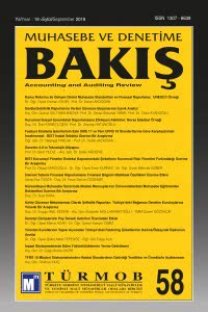KALİTE MALİYETLERİ VE YAŞAM BOYU MALİYETLEME YÖNTEMİ
Bu çalışmada, yaşam boyu maliyetleme yöntemi ile kalite maliyetleri arasındaki ilişki incelenmektedir. Yaşamboyu maliyetleme yönteminde mamulün tasarımından satış sonrasında ömrünü tamamlayıncaya kadar geçen tümsüreç maliyetleri esas alınmaktadır. Kalite maliyetlerinin yönetiminde ise mamulün üretimi başlamadan sıfır hata hedeflenmektedir. Üretim süreci sıfır hata amacına uygun olarak düzenlenmektedir. Böylece hatalı ürünlerdenkaynaklanan ilave maliyetlerde önemli ölçüde tasarruf sağlanabilir. Kalite maliyetlerinin özellikle de önlememaliyetlerinin etkin bir biçimde yönetilmesi, mamulün yaşam süresince işletmeye yükleyeceği maliyetlerin minimize edilmesine katkıda bulunur
Anahtar Kelimeler:
Maliyet Yönetimi, Kalite Maliyetleri, Yaşam Boyu Maliyetleme
QUALITY COSTS AND LIFE CYCLE COSTING
In this study, the relationship between lifelong costing method and quality costs was examined. In the lifelongcosting method, all the process costs that exist since the design of the product until the expiration after sales aretaken into consideration. In the management of quality costs, zero defects is aimed before the production. Themanufacturing process is organized in accordance with the aim of zero defects. Thus, important savings can beafforded in the additional costs caused by defective products. Effective management of quality costs, especiallythe prevention costs, contributes to the minimization of costs that the product installs on the business in its lifespan
Keywords:
Cost Management, Quality Costs, Life-Cycle Costing,
___
- CARR, Lawrence P.– PONEMON. Lawrence A. (1992). “Managers’ Perceptions About Quality Costs”. Journal of Cost Management, Spring 1992.
- CROZER, Yoram (2008). “Life cycle costing for innovations in product chains”. Journal of Cleaner Production
- DALRYMPLE, Douglas J. – PARSONS, Leonard J. (2000). Marketing Management. John Wiles&Sons, 7th Edition.
- DUNK, Alan S. (2004). “Product Life Cycle Cost Analysis: the Impact of Customer Profiling, Competitive Ad- vantage, and Ouality of IS Information”, Management Accounting Research, Vol.15.
- DUNK, Alan S. (2007). “Assessing the Effects of Product Quality and Environmental Management Accounting on the Competitive Advantage of Firms”. The Australasian Accounting Business&Finance Journal, February, Vol , No1.
- ERDEN, S. Aziz (2004). Stratejik Maliyet Yönetimi. Türkmen Kitabevi, İstanbul.
- GERSİL, Aydın (2007). “Ürün Yaşam Seyri Maliyetleme Yöntemi ve Bir Örnek Uygulama”. Muhasebe ve De- netime Bakış Dergisi, Sayı: 21.
- GLUCH, Pernilla – HENRIKKE, Bauman (2004). “The life cycle costing (LCC) approach: a conceptual dis- cussion of its usefulness for environmental decision-making”. Building and Environment, 39.
- GUTSCHELHOFER, Alfred – ROBERTS, Hanno (1997). “Anglo-Saxon and German Life-Cycle Costing”.
- The International Journal of Accounting,Vol 32, No 1. HANSEN, Don R. – MOWEN, Maryanne M. (1992). Management Accounting. South Western Publishing Com- pany, Cincinnati.
- İSLAMOĞLU, Ahmet Hamdi (2000). Pazarlama Yönetimi. Beta Yayınevi, İstanbul.
- KARAFAKIOĞLU, Mehmet (2005). Pazarlama İlkeleri, Literatür Yayınları, İstanbul, Kasım 2005.
- KARAKAYA, Mevlüt (2007). Maliyet Muhasebesi. Gazi Kitabevi, Ankara.
- KONDO, Yoshio (1990). “Key Points In Quality Control Training Courses For Managers”, Total Quality Mana- gement, Number 3.
- NOORTWIJK, Jan M. Van (2003). “Explicit formulas for the variance of discounted life-cycle cost”. Reliabi- lity Engineering and System Safety, 80.
- ÖZENCİ, B. Tayfun- CUNBUL, Ö.Lütfi (1998). Kalite Ekonomisi. Kalder Yayınları :2, İstanbul.
- RODCHUA, Suhansa (2006). “Factors, Measures, and Problems of Quality Costs Program Implementation in the Manufacturing Environment”. Journal of Industrial Technology, Volume22, Number 4-October 2006 through December 2006.
- SCHNEIDERMAN, Arthur M. (1986). “Optimum Quality Costs and Zero Defects : Are They Contradictory Concepts?” Quality Progress, November 1986.
- ISSN: 1307-6639
- Yayın Aralığı: Yılda 3 Sayı
- Başlangıç: 2000
- Yayıncı: TÜRMOB
Sayıdaki Diğer Makaleler
YÖNETİM MUHASEBESİNDEKİ DEĞİŞİM VE DEĞİŞİMİ ETKİLEYEN FAKTÖRLER
Şakir SAKARYA, H İbrahim ÖZMEN
ÇALIŞAN MORALİ VE İŞTEN AYRILMA İSTEĞİ: MUHASEBECİLİK MESLEĞİ ÜZERİNE BİR ARAŞTIRMA
Ali Ender ALTUNOĞLU, Başak ÇATALOĞLU, Algın OKURSOY
KALİTE MALİYETLERİ VE YAŞAM BOYU MALİYETLEME YÖNTEMİ
Ercan BAYAZITLI, Yusuf KADERLİ, Eymen GÜREL
RİSK ODAKLI İÇ DENETİM: TÜRKİYE’NİN 500 BÜYÜK SANAYİ İŞLETMESİNDE AMPİRİK BİR DEĞERLENDİRME
